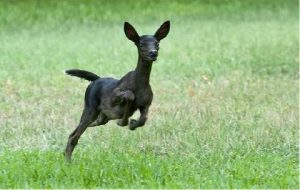
Black Sheep of the Family

Photo by Richard Buquois. Used with permission.
A black angus calf? An exotic species of deer? Nope, it’s an “oxymoronic cervid”…or black whitetail. And nothing about this fawn’s color, except the underside of its tail, appears to be normal. In the game of genetic roulette, this is the rarest of the rare.
Black deer are so rare that when photos of this fawn began circulating on the internet in 2010, someone contacted Snopes.com to see if the pictures had been photoshopped. But the photos, and the deer, were indeed real.
The pictures were taken by photographer Richard Buquois near Austin, in central Texas, where there is a small concentration of black deer. White deer have an absence of the pigment melanin, but black deer (also known as melanistic deer) have an excess of the pigment. White or albino deer occur in an estimated 1 in 20,000, but black deer are so rare there are no statistics for their occurrence.
Deer aren’t the only animals that can have a black variation. A melanistic bobcat was trapped this past fall in New Brunswick, Canada. Melanistic bobcats are even more rare than black deer, with only 12 being recorded EVER in all of North America!
The gene for excess melanin production, like the gene for no melanin production, is recessive, so normal-colored parents must each carry at least one gene for the trait for it to be passed on to any offspring. The odds are still very low that the abnormal color will appear in the next generation. Usually…
In 2011, a herd of white ewes, all bred by a single white ram, produced 100% black lambs (the sheep equivalent to black deer). Neither the farmer nor biologists had an explanation. Early studies of the white deer at the Seneca Army Depot in New York state also indicate the white coat color in this population may actually be dominant–another reversal of “bio-logic.”
Only a few black deer have ever been sighted in Wisconsin. Sauk County, however, does have a couple of black squirrel populations: one in North Freedom, and another in nearby Reedsburg. Reedsburg, in fact, devotes an entire page on its city website to its black squirrels.
Scientists are unsure what causes color variations, but genetic changes like this over thousands of years have probably given us most of the color differences we see in animals throughout the world today.

